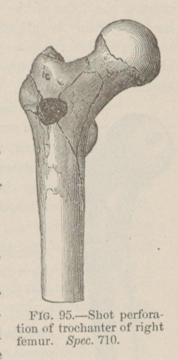Title: Johnson, P.
Source text: The Medical and Surgical History of the War of the Rebellion. (1861-65.), Part 3, Volume 2 (Washington, DC: Government Printing Office, 1883), 141.
Civil War Washington ID: med.d2e6259
TEI/XML: med.d2e6259.xml
CASE 306.—Private P. Johnson, Co. C, 2d Delaware, was wounded at the battle of Fredericksburg, December 14, 1862 by a conoidal musket ball, which entered the upper part of the right thigh in front and passed out at the nates, having in its course divided the femoral artery and perforated the great trochanter. Except that the primary hæmorrhage was slight, little is known of the early history of the case. On December 25th the wounded man was conveyed to Washington and placed in the Douglas Hospital. On admission, nearly the entire injured limb was gangrenous, and it was believed that the fracture extended into the hip joint. Surgeon P. Pineo, U. S. V., decided to amputate at the hip joint, "with no hope of a favorable result, but to mitigate patient's distress in the last moments of life." On December 27th, anæsthesia being induced by ether, the operation was performed. The patient survived it only a few hours. The pathological specimen was sent to the Army Medical Museum. It presents an oblique shot perforation through the great trochanter, with radiating fissures which separate the trochanter and neck in four large fragments and run obliquely down the shaft. Traces of the results of periostitis are visible along the outer aspect of the shaft.¹
¹ See Circular 6, S. G. O., 1865, p. 50., CASE 10; Catalogue of the Surg. Sect. of the Army Medical Museum, 4to, 1866, p. 248; Circular 7, S. G. O., 1867, pp. 35 and 62.
